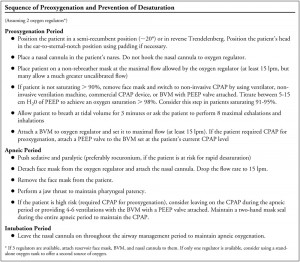Causes of stridor
Category Archives: Critical Care
The daily educational pearl – management of increased intracranial pressure
Management of increased intracranial pressure in the emergency department
The daily educational pearl – abdominal compartment syndrome
Abdominal compartment syndrome
= organ dysfunction caused by intra-abdominal hypertension
The daily educational pearl – management of rhabdomyolysis
Management of rhabdomyolysis
The daily educational pearl – apnoeic oxygenation
Apnoeic oxygenation is a concept introduced by Scott Weingart to minimize the risk of critical hypoxia during emergency tracheal intubation.
This is the summary of how you should do it:
And if you have time to read the whole article, it is highly recommended.
The daily educational pearl – steps in DKA management
Steps in DKA management
This post will only detail the steps that you need to make sure you go through when managing a patient with DKA, it will not go into any specific details regarding doses / frequency / timing.
1. Resuscitation / iv fluid therapy
– A/B/C – patients might present with circulatory collapse / altered mental state due to severe acidosis / metabolic disturbances (especially hypo or hyperK)
– early iv fluid resuscitation / therapy is very important; however be aware of the risk of cerebral oedema (especially in children) and exercise caution after the 2nd liter of fluid in adults and in children only give 10 mls/kg boluses then review carefully
2. Insulin therapy
– as per the local protocol; usually 0.05 – 0.1 units/kg/hr; the use of a bolus dose is controversial as it might increase the risk of cerebral oedema
– start with a lower dose in patients in renal failure
3. Dextrose – to start when BSL <15.0 mmol/L; consider using 10% instead of 5% if the patient is fluid overloaded or at risk of cerebral oedema
4. Electrolyte replacement
– K (caution if already low when you start insulin as it will drop further, or if in acute renal failure or anuric)
– phosphate
– Mg
5. Look for the cause of decompensation – infection / CNS event / alcohol binge etc.
6. Monitor closely for complications of therapy – hypoglycaemia / rapid shift in electrolytes with arrhythmia or altered mental state / seizures / cerebral oedema
The daily educational pearl – status epilepticus
Status epilepticus = continuous or intermittent seizures for more than 5 minutes without recovery of consciousness (after 20 min – very high risk of irreversible neurologic damage)
Non-convulsive status epilepticus = abnormal mental state or confusion, with no overt seizure activity or subtle motor signs (twitching, blinking, eye deviation); usually diagnosed on EEG
Epilepsia partialis continua = focal tonico-clonic seizure with NORMAL alertness; can be mistaken for pseudoseizures
Complications of status epilepticus
– irreversible cerebral injury (mainly secondary to hypoxia)
– hyperthermia + DIC
– hypoglycaemia
– rhabdomyolysis + ARF
– profound lactic acidosis
– cardiac dysrhythmias, pulmonary oedema
– injuries – head / spine / limbs / other
The daily educational pearl – TRALI
Transfusion related lung injury (TRALI)
= acute dyspnoea with hypoxia and bilateral pulmonary infiltrates during or within 6 hours of transfusion, not due to circulatory overload or other likely cause
Shocked? CHOD Is the Answer
Trying to work out what is causing your patient’s shocked state is not only of diagnostic importance but will also guide you management, but first:
Be Prepared
We are often given warning of the impending arrival of high acuity patients by pre-hospital teams.
So how do you approach this vital and often short period of time ?
